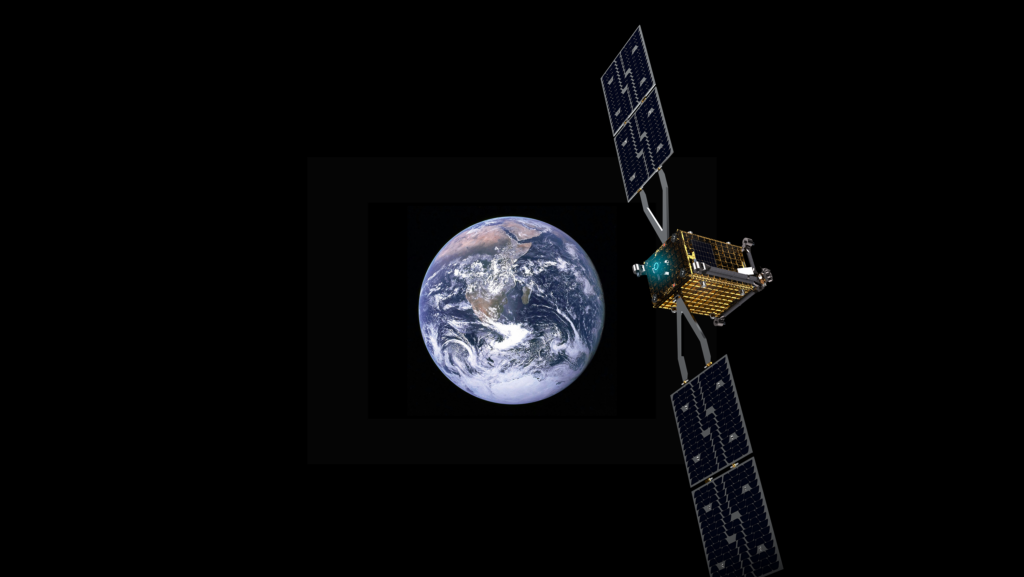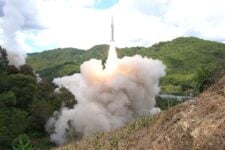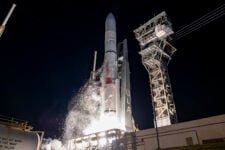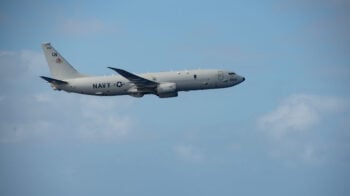
An artist’s rendering of Starfish Space’s Otter satellite servicing vehicle. (Courtesy Starfish Space)
WASHINGTON — Despite growing interest from operators at US Space Command and an emergent commercial industry, the Space Force is taking a cautious approach to acquiring capabilities for on-orbit servicing, such as refueling and/or repairing satellites — undertaking cost-benefit studies and a few experiments, rather than making any kind of long-term financial commitment.
Lt. Gen. Philip Garrant, the head of the service’s major acquisition unit Space Systems Command (SSC), on May 21 said that it won’t be until “the next generation” that Space Force satellites, at least for certain mission areas, will have a “requirement” to have capacity for refueling on orbit.
The idea, he and other Space Force officials explain, is to extend satellite lifetimes and save money on replacing them, as well as to allow them to maneuver more often to, for example, keep tabs on (or possible interfere with) enemy satellites.
“In the longer term, the constellations will incorporate that into their capabilities,” Garrant told the Mitchell Institute.
However, he said, the “jury is still out” for those kinds of capabilities being developed over “the next 10 or 15 years” as the service tries to figure out: “Does it make sense?”
The bottom line, according to Garrant, is that while the Space Force thinks “it’s an important capability,” there needs to be more analysis about what to do in the near term.
In recent weeks, senior Space Force officials have questioned both the “military utility” and the cost-effectiveness of refueling large satellites stationed in geosynchronous Earth orbit (GEO).
Garrant stressed that in order to refuel a GEO sat, “you still have to get the gas tank to space … and that’s not a trivial matter. That’s a high-energy launch. And it’s not inexpensive.”
The cost tradeoffs regarding development refueling capacity is a key factor being considered by the Space Force, especially, as Chief of Space Operations Gen. Chance Saltzman pointed out in an April 30 House Appropriations Committee hearing, the service is trying to build a more resilient space architecture using large constellations of smaller satellites in lower orbits.
“We’re trying to get the balance just right and make sure that all the dollars that we invest will be properly utilized,” he said.
Refueling is just one of several capabilities that fall under the rubric of what the Space Force often refers to as “space access, mobility and logistics” (SAML), aimed at allowing SPACECOM operators to undertake “dynamic space operations.” And across that portfolio, the Space Force is taking a very deliberate approach — with officials increasingly suggesting that consideration of these capabilities is a job for the nascent Futures Command that is focusing on needs 15 to 20 years out. For the meantime, therefore, the service generally is concentrating on analysis and experimentation.
Small Money, Multiple Experiments

Astroscale US is building a prototype satellite for refueling other satellites on orbit under a Space Force contract worth $25.5M. (Graphic: Astroscale US)
Garrant explained that Bulson’s office is using the $30 million Congress appropriated in the fiscal 2024 budget for on-orbit servicing “to get after novel ideas and to do some demonstrations and prototypes.”
For example, last September [PDF] SSC awarded Astroscale a contract worth $25 million to develop a refueling vehicle and demonstrate it on orbit by 2026.
The Space Force requested requested another $20 million for the office in FY25: $16 million for “on-orbit mobility services, including refueling” and another $4 million to explore delivery of cargo through suborbital space on a rocket (what the service now calls Point-to-Point Delivery, or P2PD).
Beyond refueling, the Space Force also is exploring other ways to increase satellite mobility and lifespan.
The service on May 20 announced [PDF] it had awarded Starfish Space a $37 million contract “Strategic Funding Increase (STRATFI) contract to build, launch, and operate an Otter satellite vehicle for a first-of-its-kind docking mission designed to provide two years of augmented maneuver for National Security Space assets.” Essentially, the target satellite would use the Otter as a new attached engine.
Col. Joyce Bulson, director of SSC’s Servicing, Mobility and Logistics Office, explained in the press release that “augmented maneuver” could be an alternative to refueling, or undertake a variety of other tasks such as simple life extension or end-of-life disposal.
Further, a spacecraft that can dock with other satellites, even those not specially designed to allow that, also could be used to make repairs or to upgrade hardware and software — something the Defense Department’s far future organization, DARPA, is working on with Northrop Grumman’s SpaceLogistics unit with the Space Force in mind as a transition partner.
Business Case Blues
Space Force would also love to tap into the emergent commercial industry for SAML capabilities, but one question is whether there is actually an emergent commercial demand.
“Is there a commercial market around SAML that goes beyond the DoD?” Col. Rich Kniseley, who runs the Space Force’s Commercial Space Office (COMSO), said during a May 17 event sponsored by the Washington Space Business Roundtable. “[B]ecause SAML is … still kind of in its infancy, we need to make sure that before the Space Force would go all in, that there’s a business case for a commercial company to survive if the government’s not there.”
He stressed that there is a lively SAML market developing that is impressive, but it’s early days.
“I would say through the Front Door, say at least 40 percent of the companies that we see have a SAML-type capability. … But we are still running a modeling and [simulation], and we’re utilizing the limited budget that we have right now to the best of our ability,” he said.
Carissa Bryce Christensen, who heads consulting firm BryceTech, told Breaking Defense that at the moment it is hard to see where the commercial on-orbit servicing market is going — in part because DoD and the Intelligence Community are struggling with “complex” questions about utility, budget tradeoffs and its perceived priorities in the short and long term.
“My answer to that question of ‘is there a market?’ would be: ‘We can’t possibly answer that at the aggregate level.’ In some sub-sectors there is, in some sub-sectors, there isn’t,” she said.
There “absolutely” is a market for “life-extension services,” Christensen noted. “The first thing that I think comes to mind is really expensive national security assets that might be still functioning and coming to the end of their lives — might be a system where a new architecture is more desirable, but there’s a benefit to extending the life of the existing system.”
In this case, Christensen said, there also could be a growing commercial market, with owners of big telecommunications satellites who are looking to shift focus toward lower orbits deciding to extend the life of their fleets rather than putting up a new constellation.
But, she cautioned that even in the case of national security satellites, a “satellite-by-satellite decision” will be required.
National security space decision-makers have to ask themselves a number of different questions about what is a “complex dynamic,” Christensen said. “How much should we be buying from these providers? Do we just buy what we need right now? Do we buy a little bit more than we think we need to keep them in business?”
And officials can come at those in slightly different ways — meaning that there isn’t necessarily a disconnect between SPACECOM and Space Force, she noted.
But, writ large, Christensen isn’t convinced most new commercial space companies currently being funded by venture capital — whether looking to provide satellite servicing or remote sensing or delivery via rocket — will be able to make it long term without Pentagon and IC dollars.
“I think the US national security community is going to shape commercial space for the foreseeable future,” she said.






















